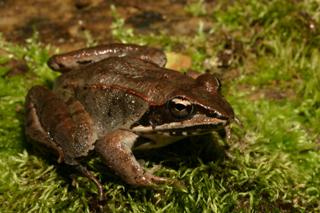Aug 18 2015
Millions of tons of road salt are applied to streets and highways across the United States each winter to melt ice and snow and make travel safer, but the effects of salt on wildlife are poorly understood.
 CWRU researchers suggest early salt exposure may weaken juvenile frogs' immunities or cause other unseen physiological effects. They are investigating further. Credit: Michael f. Benard
CWRU researchers suggest early salt exposure may weaken juvenile frogs' immunities or cause other unseen physiological effects. They are investigating further. Credit: Michael f. Benard
A new study by biologists from Case Western Reserve University suggests exposure to road salt, as it runs off into ponds and wetlands where it can concentrate--especially during March and early April, when frogs are breeding--may increase the size of wood frogs, but also shorten their lives.
Wood frog tadpoles exposed to road salt grew larger and turned into larger frogs at metamorphosis than those raised without being subjected to the contaminant, researchers found.
But, contrary to expectations that larger body mass is associated with greater survival, frogs exposed to salt as tadpoles had a higher mortality rate as juveniles.
"This study really shows that you need to look across multiple life stages to get a good look at what environmental pollutants are doing," said Kacey Dananay, a Case Western Reserve PhD student who led two experiments in the study.
Dananay worked with Biology Professor Michael Benard, Katherine Krynak, who recently earned a PhD at Case Western Reserve, and Tim Krynak, project manager for Natural Resources at Cleveland Metroparks. Their findings are published online in the journal Environmental Toxicology and Chemistry.
"Most studies have shown that exposure to salt reduces the size of tadpoles," Benard said, but those were done in labs, where the tadpoles are fed regularly and the climate is controlled.
The researchers wanted to see what happens in the frogs' natural habitat.
Benard, Tim Krynak, Katherine Krynak, and several field assistants sampled public and private lands, including many sites in Cleveland Metroparks, to determine where amphibians breed naturally in Northeast Ohio. They tested whether the frog's presence, abundance, size or stage of developmental were associated with road salt contamination at 30 wetlands.
They dipped nets into the water for a certain period of time and collected up to 30 specimens, then measured for growth and developmental stage. The researchers measured the water's conductivity, which provides an estimate of road salt contamination, and overhead forest canopy, which is associated with reduced larval growth and development.
Using those variables and distance from the nearest road and rate at which tadpoles were caught, they performed statistical analyses. They found wood frog tadpoles were less abundant in wetlands with higher salt concentrations but had higher body mass.
Intrigued by these correlations, Dananay and Benard then ran two experiments in artificial ponds at the university's Squire Valleevue and Valley Ridge Farms. To test whether salt affects larval wood frog development, they added road salt in different concentrations: none, 100, 500 and 900 milligrams per liter--concentrations they'd found in the survey.
Egg masses were collected and, four and five days after hatching, the tadpoles were placed in the ponds.
The salt appeared to restrict the growth of zooplankton, which, like tadpoles, feed on pond algae, the scientists found. This likely allowed algae to grow more abundant, providing more food and resulting in larger tadpoles.
In a second experiment, half the tadpoles were raised in clean water and half in water with 500 milligrams of salt per liter. The second group grew larger and at metamorphosis transformed into larger frogs.
Juvenile frogs from both groups were randomly assigned to pens and placed either in pairs or groups of five in a total of 20 enclosures. Survival rate in the high-concentration groups was the same for juveniles that had been exposed to salt as tadpoles and those that had not. Among the juveniles in low-concentration pens, those that had been exposed to salt had a significantly lower survival rate compared to those that had not.
"We would predict the frogs that are larger at metamorphosis would do better--larger body mass is usually an indication that they are more fit," Dananay said. "Maybe they're more susceptible to disease or there's a physiological change we can't see."
Early salt exposure may have also altered how juvenile frogs allocate energy for growth and metabolism in terrestrial environments that vary in the amount of food available per frog, the researchers suggest.
Dananay and Benard are planning follow-up studies, placing tadpoles and frogs in more complicated environments as well as investigating multiple effects that may carry-over from tadpole to juvenile frog. They are also planning to study the physiological effects of salt exposure.